For years, Doctor Who has captivated audiences worldwide, and its resurgence in 2005 brought a whole new generation into the TARDIS. With a legacy stretching back to 1963, diving into Doctor Who can feel like a daunting task for new viewers. Even those focusing on the modern era (starting in 2005) face a considerable number of episodes to explore.
This guide is designed to help navigate the initial seasons of the revived Doctor Who, specifically seasons 1 through 4, plus the specials that followed, covering the adventures from 2005 to 2009. Whether you’re a newcomer wanting the essential story beats or a dedicated fan looking to refine your watch list by skipping less crucial episodes, this guide offers two paths: Must See and Watch It.
The Must See track is for viewers seeking the core narrative and iconic episodes of Doctor Who. The Watch It track is for those wanting a more comprehensive experience, aiming to enjoy most episodes while skipping only the truly stand-alone or weaker ones. If you are on the “Watch It” track, be sure to watch episodes labeled “Watch It” and “Must See.”
A note: Expect minor casting spoilers for the entire series within these recommendations, as well as some subjective opinions to guide your viewing.
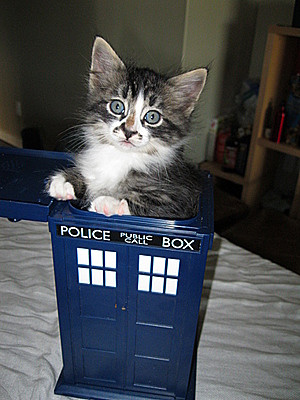 A cat curiously looking into a blue police box, symbolizing the allure of Doctor Who for new viewers.
A cat curiously looking into a blue police box, symbolizing the allure of Doctor Who for new viewers.
Season One: Christopher Eccleston’s Ninth Doctor (2005)
Season one marks the triumphant return of Doctor Who to television screens. Christopher Eccleston’s portrayal of the Ninth Doctor is instantly iconic, and these episodes are foundational for understanding the modern series.
-
“Rose”: Must see. Every series premiere is important, but “Rose” is especially crafted to be an entry point for new viewers. It introduces Rose Tyler, who becomes a central figure in the early seasons, and expertly re-establishes the core concepts of Doctor Who for a modern audience.
-
“The End of the World”: Watch it. Often aired as a two-part premiere with “Rose,” this episode expands the universe and introduces recurring characters while delving deeper into the Doctor’s past. While skippable if you’re in a rush, it enriches the early viewing experience.
-
“The Unquiet Dead”: Skip it. While enjoyable for its charming moments and connection to the season narrative, “The Unquiet Dead” is ultimately not essential viewing. Skipping it won’t significantly impact your understanding of later episodes, making it a candidate for those wanting a more concise Doctor Who episode list.
4/5. “Aliens of London”/”World War III”: Watch it. Despite featuring somewhat comical villains, this two-parter is significant for introducing Harriet Jones (MP, Flydale North), a recurring character, and for grounding the Doctor’s adventures in Rose’s personal life. This focus on the companion’s home life was a key innovation of the revived series.
-
“Dalek”: Must see. This episode is fundamental to Doctor Who lore, re-introducing the Doctor’s most infamous enemy, the Daleks. “Dalek” explores the Doctor’s trauma and guilt, providing crucial context for his character.
-
“The Long Game”: Watch it. Though not a fan favorite, “The Long Game” sets up important plot elements that pay off in the season finale. Featuring Simon Pegg and Tamsin Greig, it’s worth watching for the setup, even if the episode itself is weaker.
-
“Father’s Day”: Watch it. A mostly standalone episode, “Father’s Day” is a strong character-focused story for Rose, exploring the emotional consequences of time travel. Keep tissues handy for this poignant episode.
9/10. “The Empty Child”/”The Doctor Dances”: Watch it. Almost a “Must See”, this acclaimed two-parter introduces Captain Jack Harkness, a beloved recurring character in Doctor Who and Torchwood. It’s a genuinely excellent story – creepy, sad, and ultimately uplifting.
-
“Boomtown”: Skip it. Described as the “My Dinner With Andre” of Doctor Who, “Boomtown” is dialogue-heavy and thematically rich, exploring character dynamics. However, unless you are deeply invested in Rose’s relationship or craving more Captain Jack, it’s skippable for a streamlined Doctor Who episode list.
-
“Bad Wolf”: Watch it. Part one of the season finale, “Bad Wolf” is a satirical take on reality TV and, while not directly addressing the “Bad Wolf” mystery, culminates in a cliffhanger that leads directly into the finale.
-
“The Parting of the Ways”: Must see. The epic season finale of season one is emotionally resonant and impactful. “The Parting of the Ways” marks a significant regeneration for the Doctor (farewell, Christopher Eccleston) and sets the stage for the next era.
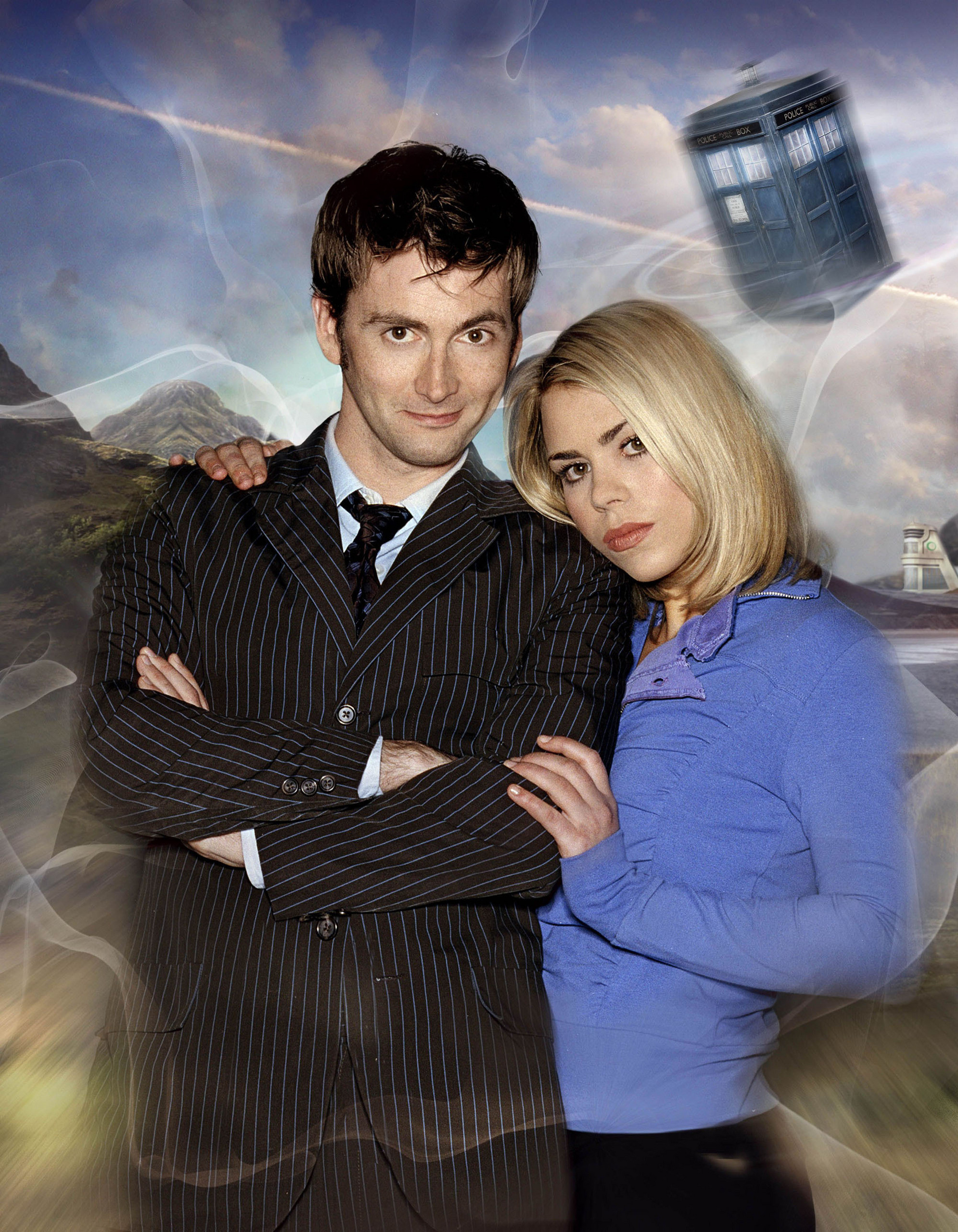 Promotional image of the Doctor and Rose from Doctor Who Season 2, highlighting their central relationship.
Promotional image of the Doctor and Rose from Doctor Who Season 2, highlighting their central relationship.
Season Two: David Tennant’s Tenth Doctor (2006)
Season two introduces David Tennant as the Tenth Doctor, a fan-favorite incarnation. This season continues to build upon the foundations of the revival, exploring new worlds and deepening character relationships.
-
“The Christmas Invasion”: Must see. Christmas specials are a Doctor Who tradition, but “The Christmas Invasion” is essential. It fully introduces David Tennant’s Tenth Doctor, brings back Harriet Jones, and establishes key plot threads for the season.
-
“New Earth”: Watch it. Serving as a sequel to “The End of the World,” “New Earth” is a body-swapping adventure that is fun and thought-provoking. While it can be viewed as standalone, it enriches the overall narrative.
-
“Tooth and Claw”: Watch it. On the surface, “Tooth and Claw” is a werewolf story featuring Queen Victoria, but it delves into deeper themes and expands the historical scope of Doctor Who’s adventures.
-
“School Reunion”: Watch it. This episode is a landmark moment for long-time Doctor Who fans, bringing back classic companion Sarah Jane Smith. With Anthony Stewart Head as the villain, “School Reunion” is a nostalgic and enjoyable episode.
-
“The Girl in the Fireplace”: Watch it. Considered one of Steven Moffat’s finest pre-showrunner episodes, “The Girl in the Fireplace” is a clever time-travel story with a romantic subplot for the Doctor.
5/6. “Rise of the Cybermen”/”Age of Steel”: Watch it. Featuring the Cybermen, a classic Doctor Who monster, this two-parter is important for the season’s overarching narrative, despite some campy elements. It’s difficult to skip due to its plot significance.
-
“The Idiot’s Lantern”: Maybe skip it? A standalone episode that can be skipped without missing crucial plot points. However, “The Idiot’s Lantern” showcases the Doctor and Rose’s charming dynamic, making it a potentially enjoyable, if non-essential, watch.
-
“The Impossible Planet”/”The Satan Pit”: Must see. This two-parter encapsulates the best of Doctor Who: action, adventure, and philosophical depth. “The Impossible Planet” / “The Satan Pit” is often cited as a prime example of what makes the show great.
-
“Love and Monsters”: Skip it. A Doctor-lite episode focusing on a fan-created monster group. While featuring a strong performance from Marc Warren, “Love and Monsters” is not essential for the main storyline.
-
“Fear Her”: Skip it. While the first part is decent, the latter half of “Fear Her” is widely considered weak. It’s best skipped for a tighter Doctor Who episode list.
10/11. “Army of Ghosts”/”Doomsday”: Must see. The emotional climax of season two, “Army of Ghosts” / “Doomsday” marks the departure of Rose Tyler. As the emotional heart of the show for two seasons, her exit makes this two-parter essential viewing and a significant moment in Doctor Who history.
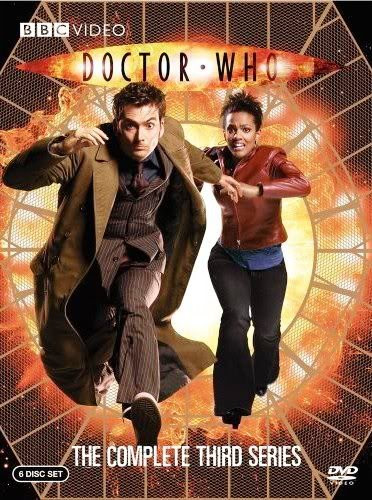 A promotional image for Doctor Who Season 3 showcasing the new companion Martha Jones and the Tenth Doctor.
A promotional image for Doctor Who Season 3 showcasing the new companion Martha Jones and the Tenth Doctor.
Season Three: Martha Jones Joins the Doctor (2007)
Season three introduces Martha Jones as the new companion, and the season explores new dynamics and challenges for the Doctor.
-
“The Runaway Bride”: Watch it. Not strictly essential, “The Runaway Bride” introduces Donna Noble, a future companion, and is packed with action and deals with the Doctor’s grief over Rose, providing emotional catharsis.
-
“Smith and Jones”: Watch it. “Smith and Jones” introduces Martha Jones as the Doctor’s new companion. This episode focuses on establishing her character and features a compelling plot set in a hospital transported to the moon.
-
“The Shakespeare Code”: Watch it. A fun historical episode featuring William Shakespeare. “The Shakespeare Code” is entertaining and showcases the Doctor’s wit in a historical setting.
-
“Gridlock”: Watch it. A follow-up to “End of the World” and “New Earth,” “Gridlock” is a well-structured episode with significant implications for the season’s overarching narrative. It expands upon the world-building established in previous episodes.
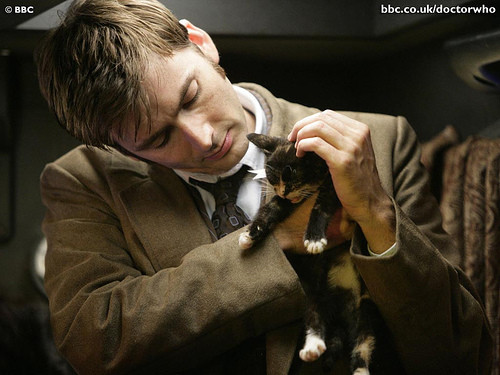 A scene from Doctor Who episode "Gridlock" showing the crowded motorway on New Earth.
A scene from Doctor Who episode "Gridlock" showing the crowded motorway on New Earth.
4/5. “Daleks in Manhattan”/”Evolution of the Daleks”: Skip it. Widely considered a low point, “Daleks in Manhattan” / “Evolution of the Daleks” is poorly paced and illogical. While set in the 1930s, which offers some visual appeal, it’s best skipped in a curated Doctor Who episode list.
-
“The Lazarus Experiment”: Watch it. Featuring Mark Gatiss and introducing important technology, “The Lazarus Experiment” is a solid episode. It also includes a nod to classic Doctor Who with the Doctor “reversing the polarity of the neutron flow.”
-
“42”: Skip it. While having minor connections to the season arc, “42” is ultimately disposable and unengaging. It’s safe to skip for a more focused viewing experience.
7/8. “Human Nature”/”The Family of Blood”: Watch it. Season three has some weaker episodes, but also some outstanding ones. “Human Nature” / “The Family of Blood” is a highlight, a near-standalone story with a compelling premise: the Doctor becomes human to hide from enemies and falls in love.
- “Blink”: Must see. Often hailed as one of the best Doctor Who episodes of the modern era, “Blink” is a masterclass in suspense and clever writing. Introducing the Weeping Angels, it’s terrifying and features a captivating performance from Carey Mulligan.
9/10/11. “Utopia”/”The Sound of Drums”/”Last of the Time Lords”: Must see. An unexpected three-part season finale, “Utopia” / “The Sound of Drums” / “Last of the Time Lords” is packed with drama and significant plot developments, including the return of Captain Jack. While some elements are over-the-top, it’s an epic conclusion to the season.
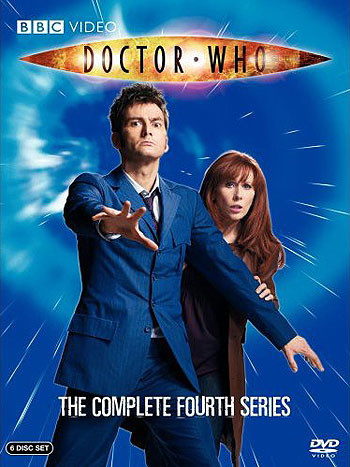 Doctor Who Season 4 DVD cover, representing the era of Donna Noble and the Tenth Doctor.
Doctor Who Season 4 DVD cover, representing the era of Donna Noble and the Tenth Doctor.
Season Four: Donna Noble Returns (2008)
Season four sees the return of Donna Noble as a full-time companion, creating a dynamic and comedic partnership with the Doctor.
-
“Voyage of the Damned”: Skip it. The “Poseidon Adventure” of Doctor Who, “Voyage of the Damned” is a disaster movie in space. While featuring Kylie Minogue and some emotional moments for the Doctor, it’s non-essential viewing.
-
“Partners in Crime”: Watch it. “Partners in Crime” marks Donna Noble’s full-time return and introduces the Adipose, some of the show’s cutest villains. The episode ends with a significant twist that propels the season’s narrative.
-
“The Fires of Pompeii”: Skip it. A decent historical episode with clever moments, “The Fires of Pompeii” is ultimately inconsequential to the overall story arc.
-
“Planet of the Ood”: Watch it. Expanding on the Ood introduced in “The Impossible Planet,” “Planet of the Ood” is a compelling episode that delves into their history and societal role.
4/5. “The Sontaran Stratagem”/”The Poison Sky”: Watch it. A solid two-parter introducing UNIT, a recurring organization in Doctor Who, and featuring the Sontarans. “The Sontaran Stratagem” / “The Poison Sky” is well-paced with good character work and action.
-
“The Doctor’s Daughter”: Skip it. “The Doctor’s Daughter” suffers from weak logic and out-of-character moments. It’s generally considered a weaker episode and skippable.
-
“The Unicorn and the Wasp”: Skip it. A fun, Agatha Christie-inspired murder mystery, “The Unicorn and the Wasp” is a standard standalone episode. Enjoyable if you like the genre, but not crucial.
7/8. “Silence in the Library”/”Forest of the Dead”: Must see. Initially just “Watch it,” “Silence in the Library” / “Forest of the Dead” became “Must See” due to the introduction of a character who becomes vital in season six. Written by Steven Moffat, it’s a spooky and well-crafted two-parter.
- “Midnight”: Watch it. A bottle episode set on a tour bus, “Midnight” is a standout standalone story, praised for its claustrophobic atmosphere and genuinely creepy premise.
9/10/11. “Turn Left”/”The Stolen Earth”/”Journey’s End”: Must see. The epic season finale. “Turn Left,” an alternate universe episode highlighting the Doctor’s importance, leads into the grand two-part finale. “The Stolen Earth” / “Journey’s End” is ambitious, emotional, and operatic in scale, marking a significant point in the Davies era.
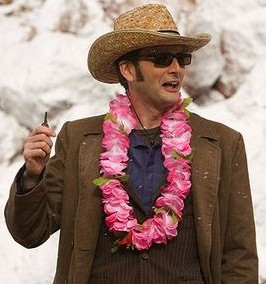 A dramatic image from "The End of Time," showcasing the emotional farewell of David Tennant's Tenth Doctor.
A dramatic image from "The End of Time," showcasing the emotional farewell of David Tennant's Tenth Doctor.
The Gap Year Specials (2009-2010)
These specials bridge season four and season five, marking the end of David Tennant’s tenure as the Doctor.
“The Next Doctor”/”Planet of the Dead”/”The Waters of Mars”/”The End of Time”: Skip it. These specials, while grand in scope, center on the Doctor’s emotional turmoil and are generally weaker in narrative quality. They can be skipped for a more streamlined experience.
However, “The End of Time” part 2 is significant for David Tennant’s regeneration into Matt Smith. If you wish to witness the regeneration without watching the full specials, consider skipping to approximately 52 minutes into “End of Time, Part 2” for the final moments of the Tenth Doctor and the twenty-minute farewell montage to the Russell T. Davies era.
With the departure of David Tennant and Russell T. Davies, a new era of Doctor Who began, led by Steven Moffat and Matt Smith.
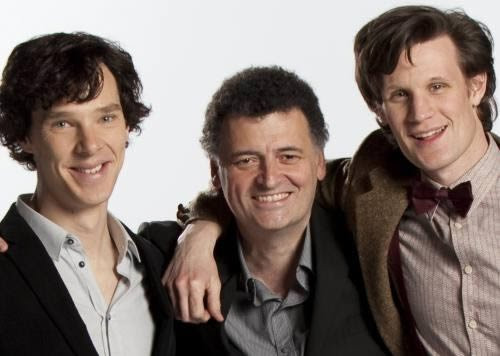 A photo of Steven Moffat, Matt Smith, and Benedict Cumberbatch, representing the new creative team taking over Doctor Who (though Cumberbatch is humorously noted as being from a different show).
A photo of Steven Moffat, Matt Smith, and Benedict Cumberbatch, representing the new creative team taking over Doctor Who (though Cumberbatch is humorously noted as being from a different show).
While opinions vary on the Moffat era, Doctor Who continued its journey as a beloved show about aタイム-traveling adventurer with a magic box. This guide provides a solid foundation for exploring the initial seasons of the revived series and deciding your own path through the vast world of Doctor Who episodes.

